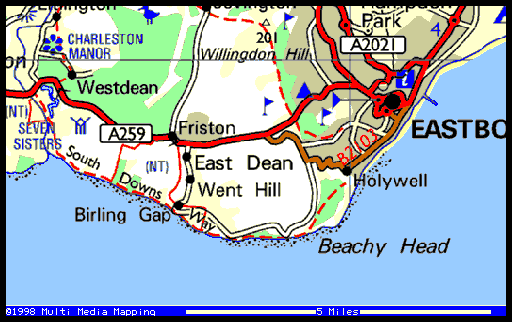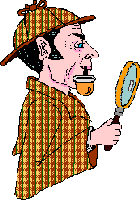Jim writes: "It appears to me that there is a fundamental difference between the Arthur Conan Doyle and Laurie R. King attributions, one which I, at least, don't know how to resolve at this point.
I dug my Annotated Sherlock Holmes out of my stored books. The most relevant discussion appears to be associated with "The Adventure of the Lion's Mane." This article continues with other matters, but is accompanied by a map with directions for locating Birling Farm "just east of West Hill." I believe that this is a misprint and that what is meant is 'Went Hill', at least if I follow the directions for locating it on their map." (ed: The map provided below is not the one from the Annotated Sherlock Holmes, but from internet mapping resources.)
The article from the Annotated Sherlock Holmes in part:
"Watson himself, in his Preface to "His Last Bow," published in 1917, has told us the Holmes chose as his retirement retreat "a small farm upon the Downs, five miles from Eastbourne . . ."
In 1953 the late Christopher Morley, on a visit to England, announced to the press that he had searched for Holmes' downland cottage -- and found it. The cottage, he declared, was "about one-and-a-half miles from salt water and about the same distance from the Seven Sisters, near a plantation of pine trees only a quarter of a mile from a No. 12 bus stop on the Eastbourne to Brighton road." Alluding to "The Adventure of the Lion's Mane," Morley added: "The cottage is stated to be at the top of the cliffs. I keep bees myself at home in Long Island, and I know that's nonsense. It was a red herring to put Moriarty's men off the scent. You can't keep bees on a cliff-top -- they need a more sheltered spot."
"An Eastbourne resident," Mr. W. H. Chenall later wrote ("The Retirement of Sherlock Holmes"), "has suggested that the cottage Morley found is one that nestles on a wooded slope above the road running southward from the village of East Dean, on the No. 12 bus route, to the coast at Birling Gap. This would be roughly the right distance from Eastbourne, but not one-and-a-half miles from the sea. It may be only half as far, but it would need to be even nearer to the sea to square with 'The Adventure of the Lion's Mane.'
"Almost every sentence in Holmes' description of the place throws up a
snag," Mr. Chenhall continued, ". . . except at Birling Gap, where the descent
to the beach is relatively short and by means of steps cut in the chalk; the cliffs
streching in either direction are high and preciptitous. If a path did exist it must have
been dangerous, and it is a wonder, as Vincent Starrett remarked, that Holmes did not
break his neck . . . . It seems unlikely that there would be . . . a beach [consisting of
a hundred yards of pebble and shingle] hereabout, where the danger of falling from the top
of the cliffs is matched by the risk of being entrapped by the tides below. The next
difficulty is 'the little cove and village of Fulworth,' breaking the long line of beach.
The only approximation to a village on the file mile stretch from
Beachy Head in the east to Cuckmere Haven in the west is Birling itself and this could
hardly be said to be in a cove. That this line of coast faces roughly south-west is a
further obstacle, if [other] statements by Holmes are considered. . . . The implication in
each case is of cliffs facing east or possibly south-east, but certainly not south-west.
It so happens, however, that there is a section of coast facing south-east at each end of
the five-mile limit. At the western end, across the Cuckmere River, the coast runs in this
direction for about half a mile before bending round to face south-west again. At the
eastern end there is a longer stretch from the top of Beachy Head (near the lighthouse) to
the final downward slope of the Downs just outside Eastbourne. The cliffs here are
different. Though high, they are not so sheer and are terraced, with green slopes and
levels. A cottage here could have the required view of the Channel and also shelter for
the bees. There is access to the beach at Cow's Gap by means of steps, as at Birling Gap.
An objection to this region is that it is much less than five miles from Eastbourne, just
as the Cuckmere area is much more."
village on the file mile stretch from
Beachy Head in the east to Cuckmere Haven in the west is Birling itself and this could
hardly be said to be in a cove. That this line of coast faces roughly south-west is a
further obstacle, if [other] statements by Holmes are considered. . . . The implication in
each case is of cliffs facing east or possibly south-east, but certainly not south-west.
It so happens, however, that there is a section of coast facing south-east at each end of
the five-mile limit. At the western end, across the Cuckmere River, the coast runs in this
direction for about half a mile before bending round to face south-west again. At the
eastern end there is a longer stretch from the top of Beachy Head (near the lighthouse) to
the final downward slope of the Downs just outside Eastbourne. The cliffs here are
different. Though high, they are not so sheer and are terraced, with green slopes and
levels. A cottage here could have the required view of the Channel and also shelter for
the bees. There is access to the beach at Cow's Gap by means of steps, as at Birling Gap.
An objection to this region is that it is much less than five miles from Eastbourne, just
as the Cuckmere area is much more."
Despite the obstacles cited by Mr. Chenhall, Mr. Charles O. Merriman, at this writing {1967} the Chairman of the Sherlock Holmes Society of London, is convinced that he has located Holmes' farm. "Inland, running east to west from Eastbourne to Birling Gap across the Downs escarpment, are only four farms," Mr. Merriman wrote in "The Game Is Afoot." "In order they are Black Robin Farm, Bullock Down Farm, Cornish Farm and Birling Manor Farm. Birling Manor Farm is sheltered in a woodland dell in the Downs about three-quarters of a mile from Birling Gap, but gives a view of the Channel from an adjoining field. The land attached to the farm rises to an eminence eastwards known as Michel Dean, which gives a commanding view of the Channel. When I was informed in the course of conversation with some of the downsfold that Cornish Farm produced acres of which clover each year and that the bees from Birling Manor Farm, the only farm of the four which keeps bees by reason of its sheltered position, feasted on the white clover after and earlie4-in-the-season diet of wild raspberry, which is prevalent on the Downs in this area, I felt my researches had at last borne fruit. I have not pursued the matter further but I should imagine that Mr. Stackhurst's school, The Gables, must lie at East Dean or Friston or its environs up to a mile north of Birling Manor Farm."
